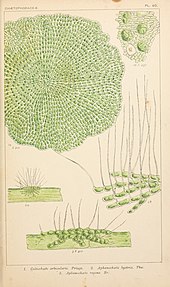Coleochaete is a genus of parenchymatous charophyte green algae in the order Coleochaetales.[1] They are haploid, reproduce both sexually and asexually, and have true multicellular organisation, with plasmodesmata communicating between adjacent cells. The plants form flat, sprawling discs on solid surfaces in freshwater streams worldwide, usually as epiphytes on aquatic plants or growing on the surface of stones. They are seen as one of two most probable sister groups to land plant species,[2][3][4] the second candidate group being the Characeae. The issue is still not resolved.[4] As they show some of the earliest and simplest features of multicellular plant growth, they are ideal model organisms in the field of synthetic biology.[citation needed] They are easy to culture and techniques that have been used to study Arabidopsis thaliana are now being applied to Coleochaete.[5]
| Coleochaete | |
|---|---|

| |
| Coleochaete sp. | |
| Scientific classification | |
| (unranked): | Viridiplantae |
| (unranked): | Charophyta |
| Class: | Coleochaetophyceae |
| Order: | Coleochaetales |
| Family: | Coleochaetaceae |
| Genus: | Coleochaete Brebisson |
Coleochaete has a sterile jacket of cells that surround the gametangia and zygotes that are protected by a layer of sterile cells after fertilization. However, unlike land plants, Coleochaete has zygotic meiosis, meiosis taking place directly in the zygote and not in diploid cells resulting from mitotic division of the zygote.[4]
Species
edit- Coleochaete divergens ("Report". Integrated Taxonomic Information System.)
- Coleochaete irregularis ("Report". Integrated Taxonomic Information System.)
- Coleochaete nitellarum ("Report". Integrated Taxonomic Information System.)
- Coleochaete orbicularis ("Report". Integrated Taxonomic Information System.)
- Coleochaete pulvinata ("Report". Integrated Taxonomic Information System.)
- Coleochaete sampsonii ("Report". Integrated Taxonomic Information System.)
- Coleochaete scutata ("Report". Integrated Taxonomic Information System.)
- Coleochaete soluta ("Report". Integrated Taxonomic Information System.)
References
edit- ^ Delwiche, C.F.; Karol, K.G.; Cimino, M.T.; Sytsma, K.J. (2002), "Phylogeny of the genus Coleochaete (Coleochaetales, Charophyta) and related taxa inferred by analysis of the chloroplast gene rbc{L}", Journal of Phycology, 38: 394–403, doi:10.1046/j.1529-8817.2002.01174.x, S2CID 84483234
- ^ "Biological systems". Archived from the original on 2009-08-21. Retrieved 2009-04-16. Benefits of the Coleochaete system
- ^ "Archived copy" (PDF). Archived from the original (PDF) on 2010-01-19. Retrieved 2009-04-16.
{{cite web}}: CS1 maint: archived copy as title (link) A biomechanical model for the study of plant morphogenesis: Coleochaete orbicularis, a 2D study species. Lionel Dupuy, Jonathan Mackenzie and Jim Haseloff - ^ a b c Becker, B.; Marin, B. (2009), "Streptophyte algae and the origin of embryophytes", Annals of Botany, 103 (7): 999–1004, doi:10.1093/aob/mcp044, PMC 2707909, PMID 19273476
- ^ "Biological systems: Index". Archived from the original on 2009-05-08. Retrieved 2009-04-16. Experimental systems for plant morphogenesis
External links
edit